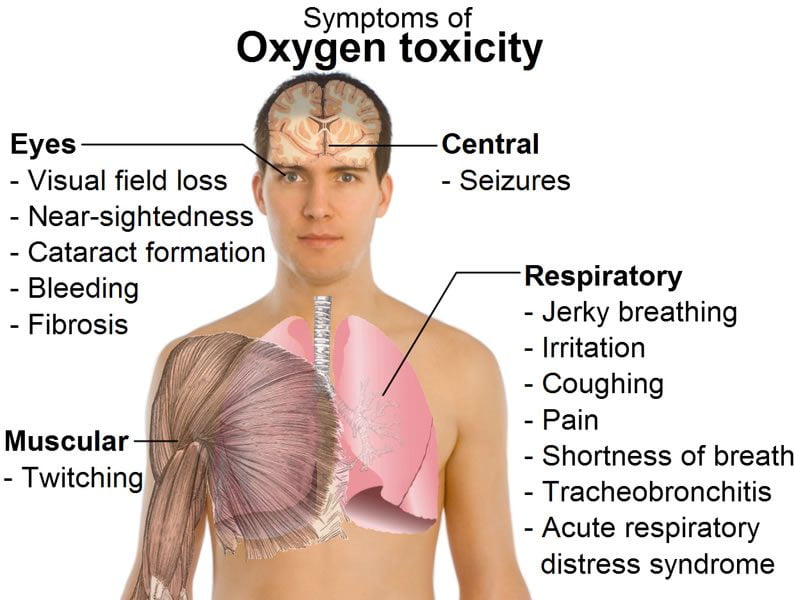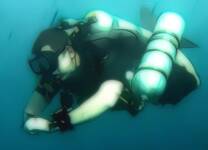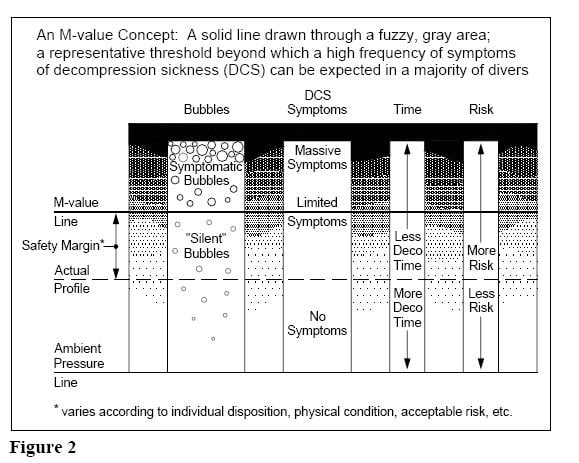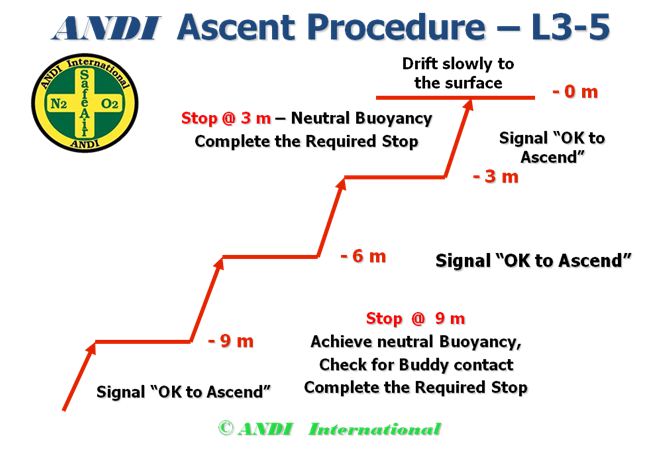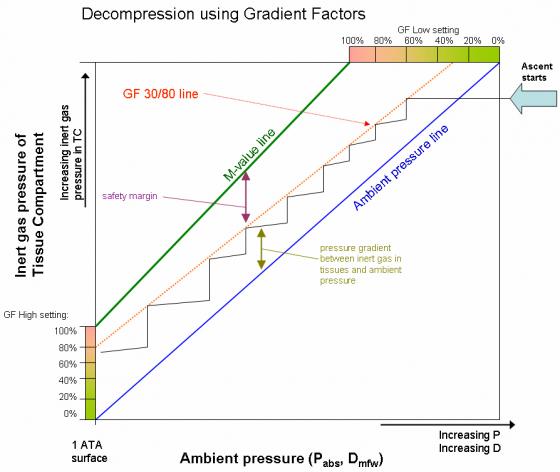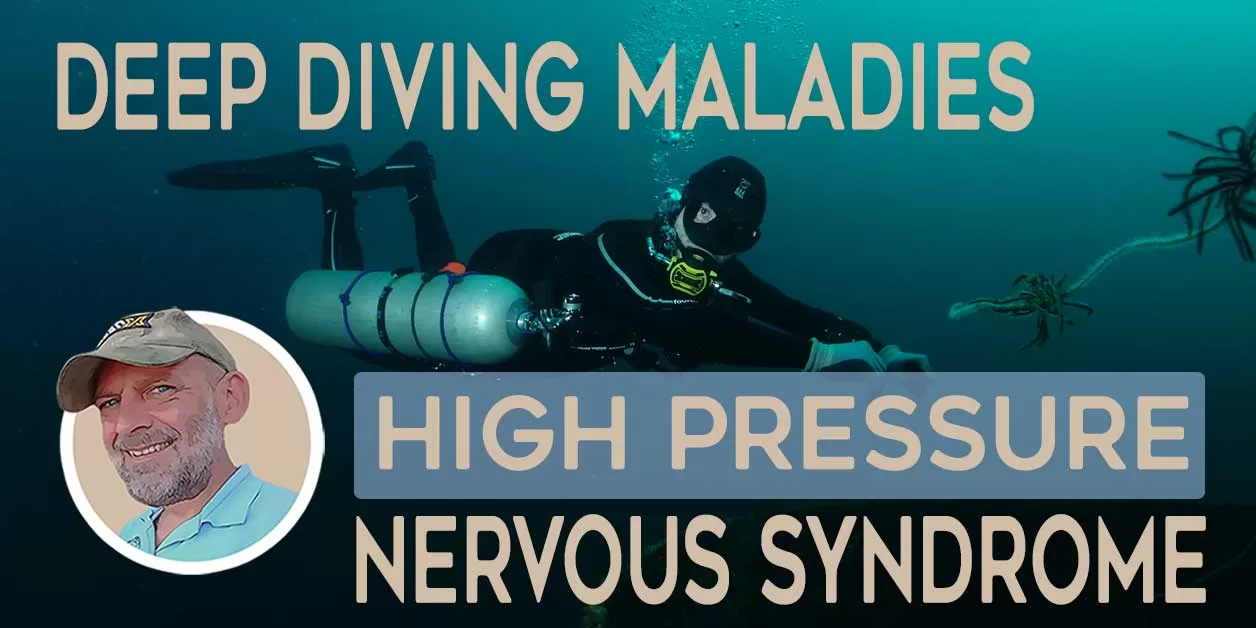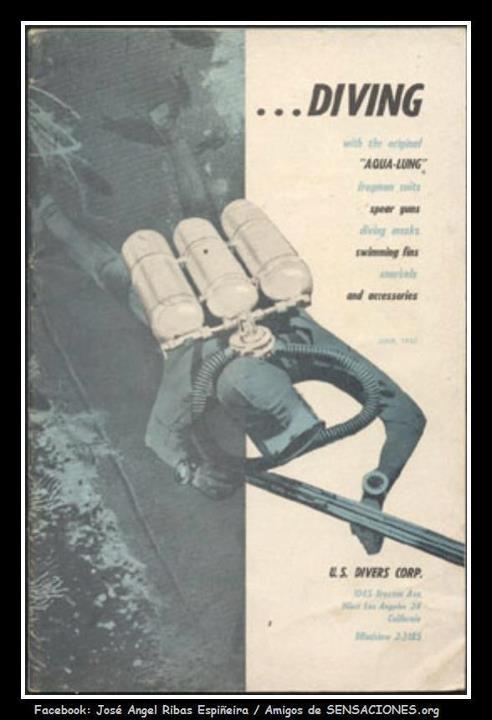Gradient Factors for Dummies
Gradient Factors for Dummies was written by Kevin Watts and first published on rebreatherworld.com. I have replicated it here because it now seems unavailable at the original site.
Gradient Factors for Dummies by Kevin Watts
(article from rebreatherworld.com)
Gradient Factors for Dummies attempts to provide a user’s view of gradient factors, an Erik Baker derived method of calculating decompression schedules. The title is not meant to be derisive, but simply an indicator that this article is meant to be a primer.
Back to Buhlmann
Everything in the gradient factor decompression algorithm revolves around Bühlmann’s tissue model (Bühlmann ZHL-16 Algorithm). Currently, this means 16 hypothetical tissue compartments (TCs) that are constantly tracked during a dive in order to determine each tissue compartment’s inert gas pressure.
As you ascend all those tissue compartments start to release pressure (“off-gas”). The question is “How fast can you let those hypothetical tissue compartments off-gas?“
Bühlmann answered that question by coming up with an “M-value”. Basically, an M-value is a maximum pressure value (different for each depth and tissue compartment) that tells you, if you exceed that value, Bühlmann thinks you’re nuts and believes you’re about to get bent.
A natural ascent strategy, then, would be to move up in the water column until the pressure in your tissue compartments just reaches Bühlmann M-value and then let your tissue compartments off-gas a bit, rise to the next level, etc. In this strategy, you would keep going up in such a way that you never let your tissue compartments exceed Bühlmann M-value.
Unfortunately, decompression illness does not exactly track Bühlmann M-values. More sickness occurs at and above the pressures represented by M-values and less sickness occurs when divers never reach Bühlmann M-values.
Become A Shearwater Power User! (eBook)
An Illustrated Guide to Gradient Factors and Advanced Shearwater Computer Settings for safe scuba diving.
42 Pages. Printable PDF format. Fully Illustrated. $9
Become A Shearwater Power User eBook
As featured on the DiveTalk Podcast
Enter Gradient Factors
Gradient factors (GFs) were invented to let the diver choose how fast, and how close, their tissue compartments get to Bühlmann M-values.
Gradient factors are calculated as follows:

What does this formula tell us?
First, the gradient factor formula tells us that at gradient factor 1.0, you are at Bühlmann M-value. Therefore, staying at or below gradient factor 1.0 seems important.
Second, it tells us that when our tissue compartment pressure just reaches ambient pressure, then the gradient factor is 0.0.
Another ascent strategy, then, might be to shoot up to a gradient factor of 0.8 and ascend in such a way as not to exceed that value. In this way, you know that your tissue compartments are never over 80% of the distance between ambient pressure and the Bühlmann M-value.
In essence, you have a 20% safety margin on Bühlmann M-values. Dive computers implementing gradient factors usually let you set two gradient factor parameters.
Moving straight to gradient factor 0.8 and ascending in such a way that you always keep your tissue compartments at gradient factor 0.8 would be equivalent to setting your dive computer to 80/80.
Erik Baker’s Strategy
Erik Baker didn’t like the idea of ascending directly to a gradient factor close to the Bühlmann M-Value. Instead, he said, “Let’s all ascend first to a lower gradient factor, then slowly move to higher gradient factors.”
So, let’s say you want to first ascend to a gradient factor of 0.30 and then slowly move to reach a gradient factor of 0.85 as you surface. This setting on your gradient factor computer is 30/85. In fact, my Shearwater computer uses 30/85 as its default setting.
So what is happening when you use a gradient factor setting of 30/85?
First, your dive computer allows you to ascend until the pressure in your tissue compartments first reaches a gradient factor of 0.3.
This means your tissue compartment pressure is 30% of the way between ambient pressure and the Bühlmann M-value. Then you sit there until your tissue compartments drop enough pressure so that you can ascend to your next stop.
How much pressure must leave your tissue compartments before you can ascend?
Assume you hit your first stop (gradient factor 0.3) at 110 ft. Well, then, we now have two known points.
- Point 1 is (110,0.3), that is, at 110ft we are at a gradient factor of 0.3.
- Point 2 is (0, 0.85), that is, at the surface, we want to be at a gradient factor of 0.85.
A natural way to ascend (and this is what Baker did) is to create a line from those two known points and ascend in such a way that you never exceed the gradient factor generated by that line.
Once you’ve determined your two points, the formula for the maximum gradient factor at any depth is:

But, since the high gradient factor is reached at the surface, high gradient factor depth =0. So,

Therefore, if you hit your first gradient factor of 0.3 at 110ft, then your low gradient factor depth=110.
Before you can ascend to 100ft you must let off enough tissue compartment pressure so that when you arrive at 100ft the gradient factor of your tissue compartments does not exceed 0.35 calculated as

You can ascend to 90ft when your tissue compartments let off enough pressure at your 100ft stop so that when you reach 90ft your tissue compartments gradient factor does not exceed 0.40 calculated as

The gradient factor method allows you to ascend by walking that line all the way to the surface.
Become A Shearwater Power User! (eBook)
An Illustrated Guide to Gradient Factors and Advanced Shearwater Computer Settings for safe scuba diving.
42 Pages. Printable PDF format. Fully Illustrated. $9
Become A Shearwater Power User eBook
As featured on the DiveTalk Podcast
Summary: Gradient Factors for Dummies
If you understood the above explanation, then you see why divers on RebreatherWorld say that setting your gradient factor parameters to 10/90, 10/80, etc, helps generate deep stops.
The low gradient factor of 10 means a stop must be generated when your tissue compartments are only 10% of the way between ambient pressure and the Bühlmann M-value, rather than 30% if you were to set the low gradient factors to 30. Simply, the gradient factor line just starts deeper.
The gradient factor method is a natural extension of Bühlmann’s tissue compartment model. Divers using computers implementing the gradient factor method should understand how modifying their gradient factors parameters will alter their decompression profiles.
My understanding is that it may be wise to consider altering your gradient factors parameters based on dive characteristics, your physical condition, and your general attitude toward the risk of decompression illness.
The gradient factor method provides the diver substantial flexibility in controlling their decompression profiles. Your responsibility is to choose the factors appropriate for you.
Safe diving!
Gradient factors for dummies videos
I have attached below the two most helpful videos explaining gradient factors on YouTube. All of my technical diving students watch these as preparation for their training courses.
Gradient factor for dummies books
I highly recommend the following two books. Both texts cover the topic of gradient factors. Mark Powell’s book “Deco for Divers” has been on my bookshelf for many years. Mark explains the topic in simply and clearly, for anyone to understand, as only a true subject matter expert can.
Other gradient factors for dummies resources
Become A Shearwater Power User! (eBook)
An Illustrated Guide to Gradient Factors and Advanced Shearwater Computer Settings for safe scuba diving.
42 Pages. Printable PDF format. Fully Illustrated. $9
Become A Shearwater Power User eBook
As featured on the DiveTalk Podcast
- Gradient Factors, by Neal W. Pollock, Ph.D. (DAN)
- Gradient Factors in a Post-Deep Stops World, by David J. Doolette (InDepth)
- A Logical Application of Gradient Factors, by Andy Davis
- Gradient Factors, by Matti Anttila Ph.D.
About The Author

Andy Davis is a RAID, PADI TecRec, ANDI, BSAC, and SSI-qualified independent technical diving instructor who specializes in teaching sidemount, trimix, and advanced wreck diving courses.
Currently residing in Subic Bay, Philippines; he has amassed more than 10,000 open-circuit and CCR dives over three decades of challenging diving across the globe.
Andy has published numerous diving magazine articles and designed advanced certification courses for several dive training agencies, He regularly tests and reviews new dive gear for scuba equipment manufacturers. Andy is currently writing a series of advanced diving books and creating a range of tech diving clothing and accessories.
Prior to becoming a professional technical diving educator in 2006, Andy was a commissioned officer in the Royal Air Force and has served in Iraq, Afghanistan, Belize, and Cyprus.
In 2023, Andy was named in the “Who’s Who of Sidemount” list by GUE InDepth Magazine.
Purchase my exclusive diving ebooks!
Gradient factors for dummies FAQ
The ZHL 16 algorithm is a dissolved gas decompression model using 16 tissue compartments. It was devised by Dr. Albert A. Bühlmann in Zurich, Switzerland. There are several versions of the algorithm, ZHL-16A, ZHL-16B, ZHL-16C, and ZHL-16ADT DD.
The Bühlmann ZHL 16 algorithm uses gradient factors as a means for users to adjust their decompression ascent profile. The high gradient factor determines the overall deco length, whilst the low gradient factor sets the depth of the first decompression stop.
The Bühlmann ZHL 16 algorithm is a mathematical model which tracks inert gases dissolved within body tissues as ambient pressure changes during a dive. It is implemented within diving computers and dive tables to allow divers to plan decompression dives.
Bühlmann ZHL-16 is a dissolved gas decompression algorithm, whereas RGBM (reduced gradient bubble model) is a free gas (bubble) algorithm. Both are used in modern scuba diving computers.
M-values are the maximum inert-gas pressure differential values for each of the 16 tissue compartments within the Bühlmann ZHL-16 decompression model. Essentially, m-values represent the point where the risk of DCS becomes unreasonable.
Two gradient factors (GF), high and low, are included in the Bühlmann ZHL-16 decompression model. They allow adjustment of the ascent profile. GF High controls overall decompression length. Whilst GF Low controls the depth of the first decompression stop.
The term m-value describes the maximum value of inert-gas pressure differential for each tissue compartment within the Bühlmann ZHL-16 decompression model.
RGBM stands for Reduced Gradient Bubble Model. It is a decompression algorithm invented by Bruce Wienke and is used in several dive computers, such as Suunto.








